Parachutist Badge
The Parachutist Badge or Parachutist Brevet is a military badge awarded by the Armed Forces of most countries in the world to soldiers who receive the proper parachute training and accomplish the required number of jumps. It is difficult to assess which country was the first to introduce such award.

France
Army
The School of Airborne Troops oversees different courses.
Military Parachute Trainee
The Military Parachute Trainee Badge (French: Brevet de préparation militaire parachutiste (PMP)) is a badge created in 1965 and aimed at reservists and national service personnel. The laureates of the Badge could serve in airborne units and eventually train at the Airborne School for the Military Parachute Badge in a short course. Since the end of the conscription in France, the PMP Badge is awarded to prospective soldiers in airborne units after a 4 weeks course.
Military Parachute Initiation

The Military Parachuting Initiation Badge (French: Brevet d'initiation au parachutisme militaire (BIPM)) was created in 1980 and aimed at military personnel outside of airborne units. It was awarded for four daytime jumps. The BIMP course was closed in 1994 for French personnel, but the Badge is still awarded to members foreign militaries after a short course at the Airborne School.
Military Parachute
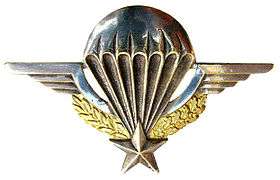
The Military Parachute Badge (French: Brevet parachutiste militaire (BPM)) is the standard course for every personnel in airborne units and all graduates of the école spéciale militaire de Saint-Cyr. It was created in 1946 and is awarded for six jumps, three daylight standard jumps, one daylight jump with the reserve parachute, one night jump without equipment, one night jump with full gear and equipment.
Parachute Monitor
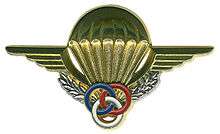
The Parachutist Monitor Badge (French: Brevet de moniteur parachutiste) is awarded to long-serving NCO in airborne units. Its graduates can teach the basics of parachute jumping to trainees, act as technical advisors on parachute matters and be jumpmasters both in units or at the Airborne Schools.
Operational Free Fall
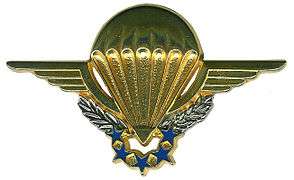
The Operational Free Fall Badge (French: Brevet de chuteur opérationnel) is awarded to graduates of long courses in Military Free Fall techniques. All graduates must have at least finished the Military Parachute Course and have some years of experience in airborne units. The Operational Free Fall Badge is part of the pipeline training for special forces and for commando platoons within the Airborne units.
High-altitude Parachute Instructor
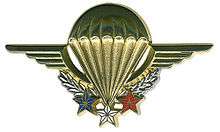
The High-altitude Parachute Instructor (French: Brevet d'instructeur au saut en ouverture commandée retardée (INSOCR)) is awarded to long-serving NCO in airborne units wishing to become jumpmasters in Free Fall jumping. All graduates must have finished the Operational Free Fall course and serve some years in an airborne unit using HALO/HAHO techniques.
Air Force
There is no Airborne School in the Air Force ; jump training is held at the (Army) Airborne School, but the Air Force uses some specific badges for advanced parachute training.
Military Parachute Initiation

The Military Parachuting Initiation Badge is awarded to graduates of a short course at the (Army) Airborne School, where the only students are Air Force cadets. It is awarded after four daytime jumps.
Military Parachute Badge

The Military Parachute Badge (Air Force) is awarded to Air Force personnel, already graduates of the (Army) Airborne School, serving in the Fusiliers Commandos de l'Air, the airborne infantry units of the Air Force. A minimum of 30 jumps is required for the award of the Air Force badge.
Special Parachute
The Special Parachute Badge (French : Brevet de parachutiste spécialisé) is the Free Fall badge of the Air Force. It is awarded after long courses at both the (Army) Airborne School and the Fusiliers Commandos Training Squadron.
Germany
Hungary
The Netherlands
The parachute course are done by the "Defensie Para School".[1] The Armed Forces of the Netherlands know 9 types of para wings:
- 'B brevet (Automatic Opening/ Static Line). Prerequisite: 5 jumps, the certificate and brevet are awarded by the Dutch sport Parachute centres at Texel and Teuge and maybe awarded by other Dutch centres if authorised.It is also awarded to foreign jumpers who qualify on Dutch soil.
- A brevet, Operational Parachutist, Static Line. Prerequisite: 8 jumps, and the last 3 have to been completed with gear and weapon, and the last one needs to be made at night. Maximum altitude: 400 meters. The course is completed by members of 11th Airmobile Brigade and Royal Netherlands Marine Corps.
- SLS brevet, Operational Parachutist, Static Line, Square.. The same as the A certificate, with the last one with gear and weapon, and the last one needs to be made at night. Only for the reconnaissance platoons of the Royal Netherlands Marine Corps
- B brevet, Parachutist Free Fall: Of the at least 20 jumps, 3 have to be made with "Accelerated Free Fall method", also a night jump has to be done. This certificate is mostly done by Parachutist riggers, and Royal Netherlands Air Force Oxygen Supervisors.
- C brevet, Operational Parachutist, Free fall. Prerequisite: 20 jumps, again 3 jumps with gear and weapon, 2 night jumps, one with gear and weapon, maximum altitude is ± 4.000 meters. All Army Commandos, need to do the course during the Phase 3 of the Commando Course, and members of the MARSOF of the Royal Netherlands Marine Corps.
- C-OPS brevet, Operation Parachutist, Free fall. Prerequisite: 10 jumps, during day and night, 8 jumps with gear, navigation console and weapon, 5 need to be made with backpack. The maximum altitude is 4.000 meters, 3 need to be a precision jump. Advanced course after the C certificate course, it focus on group jumps, and the course is for operators of the Army Commandos.
- D brevet, HALO/HAHO. Prerequisite: The amount of jumps depend on the proficiency of the student and the jumps are with a maximum altitude of 10.000 meters with oxygen. The course is only done by Commando groups, who are specialised in HALO/ HAHO jumps, and instructors of the Parachutist Training Group.
- Operational Wings: Rare wing, the last time given to a member happened on 10 March 1949 in Indonesia. For the first time since 1949, an operational jump was made again, given to 9 members of Corps command troops, Task Force 55, after a successful insertion in Afghanistan in 2009, second time given, in 2016, to 32 member of Corps command troops, the Special Operations Land Task Group in Mali, after a successful insection in 2015. and third time give, in 2017, to 8 members of the Marines Special Operations Land Task Group in Mali after a successful insection in 2015.
- Dispatcher/ Instructor wing: Rewarded after the dispatcher course, with a proficiency in Static Line and Free fall
Philippines
The AFP Parachutist Badge[2] also known as the "Airborne Badge" is awarded by the Chief of Staff, AFP to AFP Personnel, Military Cadets, and Officer Candidates who have satisfactorily completed the requirements of the Basic Airborne Course[3] set forth in the POI conducted by the Airborne School, Special Forces Regiment (Airborne).[4]
Poland

The Polish Odznaka Spadochronowa was based on the previous award called the Odznaka Pilota Wojskowego, or Military Pilot Badge. It was first introduced by notable Polish sculptor Władysław Gruberski in 1919 and was accepted shortly afterwards as the sign of all the pilots of the Polish Air Forces. The badge featured an eagle with wide spread wings, holding a laurel wreath in his bill.
In 1941, after the creation of the UK-trained 1st Independent Parachute Brigade, a similar symbol was adopted as the sign of all Polish paras. It featured a diving silver eagle. The symbol was also adopted by the cichociemni and nowadays is used by all branches of the Polish Army. Also, the Polish special unit GROM adopted a modified version of the symbol as its emblem. It is commonly (though informally) referred to as gapa (diving Eagle).
Singapore
The Silver Wings is awarded upon successful completion of the Basic Airborne Course conducted by the Parachute Training Wing, School of Commandos. First awarded to the pioneering graduating batch of 27 NSFs from Second Company, 1st Commando Battalion (1 Cdo Bn) of the Singapore Commandos Formation, it comprises a pair of outspread wings on both wigs of a deployed parachute, with the words "SINGAPURA" below the canopy. With the design sanctioned by 1 Cdo Bn's Commanding Officer, Tan Kim Peng Clarence, it is differentiated by a crimson velvet backing for Commandos, while those of the Commando Parachute Jump Instructors have a golden velvet backing. Non-Commandos wear the badge without any backing.
United Kingdom
United States
The United States Parachutist Badge (also commonly referred to as "Jump Wings") is a military badge of the United States Armed Forces which is awarded to members of the United States Army, Air Force, Marine Corps and Navy.
After making five more jumps in a jump billet, members of the Navy and Marine Corps are authorized to wear the gold wings of Naval and Marine parachutists in lieu of their initial award of Army wings. There are three versions of the Army Parachutist Badge.[5] The United States Coast Guard is the only service which does not issue a Parachutist Badge and does not have personnel serving on jump status; however, Coast Guard members are entitled to receive the Parachutist Badge of another service if the proper training was received. The badge is awarded to U.S. Armed Forces personnel upon completion of the United States Army Airborne School Basic Airborne Course or freefall (not HALO) parachute training at the United States Air Force Academy, regardless of branch or MOS.[6] The USAFA course is open only to cadets and its training focuses on parachuting for aircrew members who must exit from an aircraft in an emergency. The training is not considered preparation for operational parachute units.
If awarded, Army parachutists who meet the qualifications and jump with a foreign service may also wear one set of foreign wings on their Class A uniform.[7] According to AFI36-2903, page 139 (edition of 2 August 2006), Air Force personnel may wear foreign-awarded jump wings while stationed in the awarding country or attending an official or social function hosted by the awarding government, and if the recipient has already been awarded US jump wings.[8]
The original Army Parachutist Badge was designed in 1941 by Lieutenant General (then Captain) William P. Yarborough and approved by the Department of the Army in March of that year. In addition to the Parachutist Badge, U.S. Army paratroopers wore a "paraglider" patch on the front left side (enlisted) or right side (officers) of the garrison cap. Until the late 1940s, glider units were also included within Airborne divisions, hence the parachute and glider on the cap. The garrison cap with the paraglider patch was replaced by the maroon beret. Troops of the 101st Airborne Division (Air Assault), a former parachute unit, continued to wear the garrison cap with patch until the replacement of garrison caps by the black beret worn by all personnel not already wearing maroon (Airborne) or green (Special Forces). When the black beret was adopted Army-wide, Ranger units switched from black to tan.
The U.S Navy and Marine Corps Parachutist badge was originally known as the U.S. Navy Certified Parachute Rigger badge and designed by American Insignia Company in 1942 for graduates of the U.S. Navy Parachute Rigger School. During WWII, despite being against uniform regulations it became common for U.S. Marine Corps paratroopers who were issued the silver U.S. Army Basic Parachutist badge to wear the gold Navy Certified Parachute Rigger badge because they believed the gold "Rigger wings" looked better on their uniform.[9] This out of regulations wearing of the Parachute Rigger badge became so common that in July 1963 the Commander of United States Marine Corps Force Reconnaissance Bruce F. Meyers sent a request to Chief of Naval Operations Admrial George W. Anderson Jr. via Marine Corps Commandant General David M. Shoup requesting to officially make the Navy Parachute Rigger badge the parachutist badge for the Navy and Marine Corps. The request was approved by Admiral Anderson on July 12, 1963 per BuPers Notice 1020.[10] Since 1963, being a graduate of the U.S. Navy Parachute Rigger School is no longer a requirement to earn the badge.
 U.S. Army & Air Force Basic Parachutist Badge
U.S. Army & Air Force Basic Parachutist Badge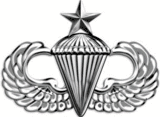 U.S. Army & Air Force Senior Parachutist Badge
U.S. Army & Air Force Senior Parachutist Badge U.S. Army & Air Force Master Parachutist Badge
U.S. Army & Air Force Master Parachutist Badge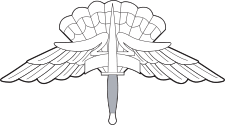 U.S. Army & Air Force Freefall Parachutist Badge
U.S. Army & Air Force Freefall Parachutist Badge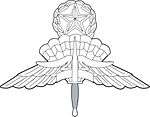 U.S. Army & Air Force Master Freefall Parachutist Badge
U.S. Army & Air Force Master Freefall Parachutist Badge U.S. Navy & Marine Corps Parachutist Badge (originally known as the U.S. Navy Certified Parachute Rigger badge, 1942-1963)
U.S. Navy & Marine Corps Parachutist Badge (originally known as the U.S. Navy Certified Parachute Rigger badge, 1942-1963)
Other countries
- Argentina: In the Argentinian Army, personnel who complete the basic parachutist training receive a badge consisting of a silver winged parachute. A golden badge is awarded to personnel after a certain service time spent at a parachute unit, after a certain number of jumps and upon completion of at least two more parachute-related courses besides the basic one, such as rigger, jumpmaster, free-fall jump, etc. This system replaced the one existing until 1993, when officers wore the golden badge, NCOs the silver one and privates a smaller silver one. Navy, Air Force and Gendarmerie parachutists were similar badges to those of the Army.
- Czechoslovakia: Czechoslovak badges were awarded in three classes:

- Canada: Canadian Paratroopers with Canadian Jump Wings date back to the days of the 1st Special Service Force and 1st Canadian Parachute Battalion of World War II. In 1942 Canada had its own distinctive wings, worn on the left breast above service ribbons. This style was awarded until 1968 when the current wings were introduced. There are two classes of Canadian Jump Wings, red maple leaf for completion of the Basic Parachutist's Course, and white maple leaf for completing the course and sufficient months of service in a designated parachutist's position. The Canadian Airborne Regiment (April 1968 to March 1995) were the most well known wearers of the Canadian Jump Wings. After its disbandment in 1995, the Canadian army's parachute traditions reverted to the pre-1968 practice of maintaining a parachute company within one of the battalions of each of the regular infantry regiments. Many of the Airborne Regiment's soldiers, returned to their regimental "homes" and stood up companies in the light battalion of each of their regiments (the 3rd Battalion The Royal Canadian Regiment, the 3rd Battalion Princess Patricia's Canadian Light Infantry and the 3rd Battalion Royal 22e Régiment). These soldiers are entitled to wear the white leaf jump wings. Foreign service members and all other graduates who complete the Canadian basic parachutist course will receive the red leaf jump wings.
Gallery of badges from around the world
- Australia
 Bulgaria
Bulgaria Canada
Canada The Czech Republic
The Czech Republic Denmark
Denmark Bronze class, Finland
Bronze class, Finland France
France Bronze class, Germany
Bronze class, Germany Honduras
Honduras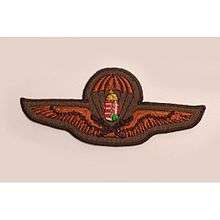 Conscript class, Hungary
Conscript class, Hungary Italy
Italy The Netherlands
The Netherlands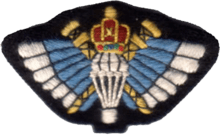 Special Forces Parachute Badge, Oman
Special Forces Parachute Badge, Oman The Philippines
The Philippines Poland
Poland Spain
Spain- UK
 Basic badge, USA
Basic badge, USA
Former countries
.jpg) East Germany
East Germany Nazi Germany
Nazi Germany South Vietnam
South Vietnam- Soviet Union
References
- ↑ http://www.defensie.nl/organisatie/landmacht/inhoud/eenheden/kct/defensie-para-school
- ↑ The AFP Adjutant General, AFP Awards and Decorations Handbook, 1997, OTAG, p. 79-80.
- ↑ Military Parachuting
- ↑ Special Forces Regiment (Airborne)
- ↑ 578.74 Parachutist badges
- ↑ Airborne School Archived 3 February 2009 at the Wayback Machine.
- ↑ Foreign badges authorized for acceptance and wear on the Army Uniform
- ↑ http://www.afoats.af.mil/OTS/documents/AFI36-2903.pdf
- ↑ Mason, Chris (2004). Paramarine!: Uniforms and Equipment of Marine Corps Parachute Units in World War II. Schiffer Pub Ltd. pp. 175–177. ISBN 9780764319242.
- ↑ "Evolution of Naval Wings" (PDF). Coast Guard Aviation History. THE U.S. COAST GUARD AVIATION ASSOCIATION. Archived from the original (PDF) on 9 February 2016. Retrieved 25 January 2016.
- ↑ 3rd Class
- ↑ 2nd Class
- ↑ 1st Class